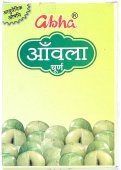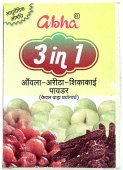Abha, Ābha, Ābhā: 22 definitions
Introduction:
Abha means something in Buddhism, Pali, Hinduism, Sanskrit, Marathi, Jainism, Prakrit, Hindi. If you want to know the exact meaning, history, etymology or English translation of this term then check out the descriptions on this page. Add your comment or reference to a book if you want to contribute to this summary article.
In Hinduism
Shaktism (Shakta philosophy)
Source: Google Books: Manthanabhairavatantram1) Ābhā (आभा) refers to “white” (like the foam of a stream of milk), according to the Śrīmatottara-tantra, an expansion of the Kubjikāmatatantra: the earliest popular and most authoritative Tantra of the Kubjikā cult.—Accordingly, “[...] (These energies) [i.e., of the syllables of the Goddess’s Vidyā?] are (white) like the foam of a stream of milk [i.e., kṣīradhāra-ogha-phena-ābhā] and their light is like the lustre of the moon. They rain down in a great stream onto the body with drops that are (like) streams of milk. One should think that the Self is there in middle (of the body) and its colour is (white like) milk. O goddess, this is the Wheel of the Moon”.
2) Ābhā (आभा) refers to the “light” (of the stars), according to the Devīpañcaśataka, an important source of the Kālīkrama that developed in Kashmir after the Kālī Mata of the Jayadrathayāmala.—Accordingly, “The permutation (of the Transmental) is said to be the Light that precedes the mistress of the Wheel of Rays [i.e., puñjacakra-īśī] (of divine consciousness). [...] (That light) is not the moon, (or) the light of the stars [i.e., tārakā-ābhā]; it is not the light of the rays of (the sun), the lord of the sky, nor is it the brilliance of lightning—nor is it like the beautiful sun (of energy). That Light (bhāsā) is seen in the belly (of consciousness) with the eye of knowledge, that is, in the eye on the path of opening (unmeṣa). [...]”.—(Cf. Puñjacakra).

Shakta (शाक्त, śākta) or Shaktism (śāktism) represents a tradition of Hinduism where the Goddess (Devi) is revered and worshipped. Shakta literature includes a range of scriptures, including various Agamas and Tantras, although its roots may be traced back to the Vedas.
Purana and Itihasa (epic history)
Source: archive.org: Shiva Purana - English TranslationĀbhā (आभा) refers to “lustre”, according to the Śivapurāṇa 2.3.8.—Accordingly, Nārada said to Himavat:—“[..] O lord of mountains, Śiva will become Ardhanārīśvara (half male and half female), with your daughter forming half the part of your body. Their meeting once again will be delightful. After propitiating lord Śiva, the lord of all, by the power of her penance, your daughter will take away half the body of Śiva. By propitating Śiva with her penance she will acquire the lustre of gold [i.e., suvarṇa-ābhā] and will be known as Svarṇagaurī. Your daughter will be as fair-complexioned as lightning. [...]”.

The Purana (पुराण, purāṇas) refers to Sanskrit literature preserving ancient India’s vast cultural history, including historical legends, religious ceremonies, various arts and sciences. The eighteen mahapuranas total over 400,000 shlokas (metrical couplets) and date to at least several centuries BCE.
Jyotisha (astronomy and astrology)
Source: Wisdom Library: Brihat Samhita by VarahamihiraĀbhā (आभा) refers to a “colour”, according to the Bṛhatsaṃhitā (chapter 9), an encyclopedic Sanskrit work written by Varāhamihira mainly focusing on the science of ancient Indian astronomy astronomy (Jyotiṣa).—Accordingly, “If Venus (śukra) should be of the colour of fire [i.e., anala-ābhā], there will be fear from fire; if of blood colour, there will be wars in the land; if of the colour of burnished gold, there will be disease; if green, there will be asthmatic complaints; if ashy-pale or black, there will be drought in the land. If Venus should be of the colour of coagulated milk, of the white water lily, or of the moon, or if her course be direct, or if she should be the successful planet in conjunctions, mankind will enjoy the happiness of Kṛtayuga”.

Jyotisha (ज्योतिष, jyotiṣa or jyotish) refers to ‘astronomy’ or “Vedic astrology” and represents the fifth of the six Vedangas (additional sciences to be studied along with the Vedas). Jyotisha concerns itself with the study and prediction of the movements of celestial bodies, in order to calculate the auspicious time for rituals and ceremonies.
In Buddhism
Theravada (major branch of Buddhism)
Source: Pali Kanon: Pali Proper NamesA generic name for devas distinguished for their brilliance, such as the Parittabha and the Appamanabha. M.iii.102; MA.ii.902.
Theravāda is a major branch of Buddhism having the the Pali canon (tipitaka) as their canonical literature, which includes the vinaya-pitaka (monastic rules), the sutta-pitaka (Buddhist sermons) and the abhidhamma-pitaka (philosophy and psychology).
Tibetan Buddhism (Vajrayana or tantric Buddhism)
Source: Wisdom Library: Tibetan BuddhismĀbha (आभ) is the name of a Tathāgata (Buddha) mentioned as attending the teachings in the 6th century Mañjuśrīmūlakalpa: one of the largest Kriyā Tantras devoted to Mañjuśrī (the Bodhisattva of wisdom) representing an encyclopedia of knowledge primarily concerned with ritualistic elements in Buddhism. The teachings in this text originate from Mañjuśrī and were taught to and by Buddha Śākyamuni in the presence of a large audience (including Ābha).

Tibetan Buddhism includes schools such as Nyingma, Kadampa, Kagyu and Gelug. Their primary canon of literature is divided in two broad categories: The Kangyur, which consists of Buddha’s words, and the Tengyur, which includes commentaries from various sources. Esotericism and tantra techniques (vajrayāna) are collected indepently.
Languages of India and abroad
Pali-English dictionary
Source: BuddhaSasana: Concise Pali-English Dictionaryābhā : (f.) light; lustre; radiance. || aṇha (m.), day; only in cpds. such as pubbaṇha.
Source: Sutta: The Pali Text Society's Pali-English DictionaryĀbhā, (f.) (Sk. ābhā, fr. ā + bhā, see ābhāti) shine, splendour, lustre, light D.II, 12; M.III, 147 (adj. —°); S.II, 150 (°dhātu); A.II, 130, 139; III, 34; Mhvs XI.11; VvA.234 (of a Vimāna, v. l. pabhā); DhA.IV, 191; Sdhp.286. (Page 103)

Pali is the language of the Tipiṭaka, which is the sacred canon of Theravāda Buddhism and contains much of the Buddha’s speech. Closeley related to Sanskrit, both languages are used interchangeably between religions.
Marathi-English dictionary
Source: DDSA: The Molesworth Marathi and English Dictionaryābha (आभ).—n C The sky. 2 Cloudiness or clouds.
--- OR ---
ābhā (आभा).—f S Light, lustre, splendor.
Source: DDSA: The Aryabhusan school dictionary, Marathi-Englishābha (आभ).—n The sky. Clouds.
--- OR ---
ābhā (आभा).—f Light, lustre.
Marathi is an Indo-European language having over 70 million native speakers people in (predominantly) Maharashtra India. Marathi, like many other Indo-Aryan languages, evolved from early forms of Prakrit, which itself is a subset of Sanskrit, one of the most ancient languages of the world.
Sanskrit dictionary
Source: DDSA: The practical Sanskrit-English dictionaryĀbhā (आभा).—2 P.
1) To shine, blaze; सुतरां रत्नमाभाति चामीकरनियोजितम् (sutarāṃ ratnamābhāti cāmīkaraniyojitam) Subhāṣ; R.3.33.
2) To appear, look like; आभासि तीर्थप्रतिपादितर्द्धिः (ābhāsi tīrthapratipāditarddhiḥ) R.5.15,7,13.14; Bhaṭṭikāvya 7.8,66.
3) To outshine.
--- OR ---
Ābhā (आभा).—[bhā-aṅ]
1) Light, splendour, lustre; तत्र ताराधिपस्याभा ताराणां भा तथैव च । तयोराभरणाभा च ज्वलिता द्यामभासयत् (tatra tārādhipasyābhā tārāṇāṃ bhā tathaiva ca | tayorābharaṇābhā ca jvalitā dyāmabhāsayat) || Rām.6.75.51 दीपाभां शलभा यथा (dīpābhāṃ śalabhā yathā) Pañcatantra (Bombay) 4.
2) Colour, appearance, beauty; प्रशान्तमिव शुद्धाभम् (praśāntamiva śuddhābham) Manusmṛti 12. 27.
3) Likeness, resemblance; oft. at the end of comp. in these two senses; रुक्माभम् (rukmābham) appearing or shining like gold; यमदूताभम् (yamadūtābham) Pañcatantra (Bombay) 1.58; मरुत्सखाभम् (marutsakhābham) R.2.1.
4) A reflected image, shadow, reflection.
Source: Cologne Digital Sanskrit Dictionaries: Edgerton Buddhist Hybrid Sanskrit DictionaryĀbha (आभ).—m. pl. (= Pali id., misprinted once Abha, see Critical Pali Dictionary s.v. Abhā), name of a class of rūpāvacara gods, of the 2d dhyāna-bhūmi, see deva (only in a few lists): Mahāvastu ii.314.7 ābhā devā(ḥ); 348.19 ābhā (v.l. ābhāś) ca (sc. devāḥ); 360.15 ābhāṃ (acc. pl.; v.l. ăbhā) paśyati devatāṃ (v.l. °tāḥ).
Source: Cologne Digital Sanskrit Dictionaries: Shabda-Sagara Sanskrit-English DictionaryĀbhā (आभा).—f.
(-bhā) 1. Light. 2. Splendour. 3. Beauty. E. āṅ before bhā to shine, aṅ and ṭāp affs.
Source: Cologne Digital Sanskrit Dictionaries: Benfey Sanskrit-English DictionaryĀbhā (आभा).—[ā-bhā], f. 1. Splendour, light, [Pañcatantra] iv. [distich] 58. 2. When latter part of a compound adj., often Like; e. g. [Rāmāyaṇa] 3, 55, 28, giri-śṛṅga-ābha, Like the peak of a mountain.
Source: Cologne Digital Sanskrit Dictionaries: Cappeller Sanskrit-English DictionaryĀbhā (आभा).—[feminine] splendour, light; likeness, [adjective] —° resembling, like.
--- OR ---
Ābhā (आभा).—shine upon, illumine; shine forth, appear, look or be like (iva, yathā or [adverb] in vat).
Ābhā is a Sanskrit compound consisting of the terms ā and bhā (भा).
Source: Cologne Digital Sanskrit Dictionaries: Monier-Williams Sanskrit-English Dictionary1) Ābhā (आभा):—[=ā-bhā] 1. ā-√bhā [Parasmaipada] -bhāti ([imperative] 2. sg. ā-bhāhi, [Ṛg-veda]; [perfect tense] -babhau)
—to shine or blaze towards, [Ṛg-veda; Atharva-veda];
—to irradiate, outshine, illumine, [Ṛg-veda; Atharva-veda; Taittirīya-brāhmaṇa; Bhāgavata-purāṇa];
—to appear, become visible or apparent, [Bhāgavata-purāṇa; Mahābhārata; Harivaṃśa; Rājataraṅgiṇī] etc.;
—to look like, [Kathāsaritsāgara; Mahābhārata etc.]
2) [v.s. ...] 2. ā-bhā f. splendour, light
3) [v.s. ...] a flash
4) [v.s. ...] colour, appearance, beauty, [Mahābhārata; Manu-smṛti; Suśruta; Pañcatantra] etc.
5) [v.s. ...] a reflected image, outline
6) [v.s. ...] likeness, resemblance, [Mahābhārata; Rāmāyaṇa]
7) [v.s. ...] (mfn.) ifc. like, resembling, appearing, [Rāmāyaṇa; Kāvyādarśa; Śiśupāla-vadha etc.] (e.g. hemābha, shining like gold);
8) [from ā-bhā] cf. [Hibernian or Irish] avibh, ‘likeness, similitude’; avibe, ‘neatness, elegance’; avibhcal, ‘a spark of fire’ ?
Source: Cologne Digital Sanskrit Dictionaries: Yates Sanskrit-English DictionaryĀbhā (आभा):—[ā-bhā] (bhā) 1. f. Beauty, splendour.
Source: DDSA: Paia-sadda-mahannavo; a comprehensive Prakrit Hindi dictionary (S)Ābhā (आभा) in the Sanskrit language is related to the Prakrit words: Ābhā, Āhā.
[Sanskrit to German]
Sanskrit, also spelled संस्कृतम् (saṃskṛtam), is an ancient language of India commonly seen as the grandmother of the Indo-European language family (even English!). Closely allied with Prakrit and Pali, Sanskrit is more exhaustive in both grammar and terms and has the most extensive collection of literature in the world, greatly surpassing its sister-languages Greek and Latin.
Hindi dictionary
Source: DDSA: A practical Hindi-English dictionaryĀbhā (आभा):—(nf) lustre, splendour; tint, tinge; ~[maṃḍala] a halo.
...
Prakrit-English dictionary
Source: DDSA: Paia-sadda-mahannavo; a comprehensive Prakrit Hindi dictionaryĀbhā (आभा) in the Prakrit language is related to the Sanskrit word: Ābhā.
Prakrit is an ancient language closely associated with both Pali and Sanskrit. Jain literature is often composed in this language or sub-dialects, such as the Agamas and their commentaries which are written in Ardhamagadhi and Maharashtri Prakrit. The earliest extant texts can be dated to as early as the 4th century BCE although core portions might be older.
Nepali dictionary
Source: unoes: Nepali-English DictionaryĀbhā (आभा):—n. 1. light; splendor; luster; 2. gleam; color; appearance; beauty; 3. likeness; resemblance; 4. a reflected image; shadow; reflection; 5. tinge;
Nepali is the primary language of the Nepalese people counting almost 20 million native speakers. The country of Nepal is situated in the Himalaya mountain range to the north of India.
See also (Relevant definitions)
Starts with (+22): Abha Sutta, Abha Vagga, Abhaa, Abhabba, Abhabba Sutta, Abhabbagamana, Abhabbata, Abhabbatthana, Abhacchastra, Abhadra, Abhadrate, Abhadre, Abhaga, Abhagadhejja, Abhagadheya, Abhagga, Abhagi, Abhagin, Abhagina, Abhagini.
Query error!
Full-text (+139): Abhash, Amitabha, Dhumabha, Vajrabha, Raktabha, Tamrabha, Acirabha, Hemabha, Kapotabha, Malabha, Dhumrabha, Suvarnabha, Talakabha, Shuddhabha, Chatabha, Apramanabha, Kukkutabha, Cillabha, Sitabha, Nilabha.
Relevant text
Search found 38 books and stories containing Abha, A-bha, Ā-bhā, A-bha-kvi, Ā-bhā-kvi, Ābha, Ābhā; (plurals include: Abhas, bhas, bhās, kvis, Ābhas, Ābhās). You can also click to the full overview containing English textual excerpts. Below are direct links for the most relevant articles:
Journal of Ayurveda and Integrative Medicine
Colles fracture management with Murivenna and Abha Guggulu: Case report < [Volume 14 (issue 4), Jul-Aug 2023]
Vrikshayurveda-based system for diagnosing plant diseases < [Volume 15 (issue 1), Jan-Feb 2024]
Rig Veda (translation and commentary) (by H. H. Wilson)
Brihad Bhagavatamrita (commentary) (by Śrī Śrīmad Bhaktivedānta Nārāyana Gosvāmī Mahārāja)
Verse 2.2.67 < [Chapter 2 - Jñāna (knowledge)]
Verse 2.2.131 < [Chapter 2 - Jñāna (knowledge)]
Sahitya-kaumudi by Baladeva Vidyabhushana (by Gaurapada Dāsa)
Text 10.74 < [Chapter 10 - Ornaments of Meaning]
Text 10.181 < [Chapter 10 - Ornaments of Meaning]
Text 4.58 < [Chapter 4 - First-rate Poetry]
Yavanajataka by Sphujidhvaja [Sanskrit/English] (by Michael D Neely)
Verse 1.133 < [Chapter 1 - The Innate Nature of the Zodiac Signs and Planets]
Verse 1.136 < [Chapter 1 - The Innate Nature of the Zodiac Signs and Planets]
Verse 2.42 < [Chapter 2 - One’s Own Form of the Horās]
Related products
(+7 more products available)





